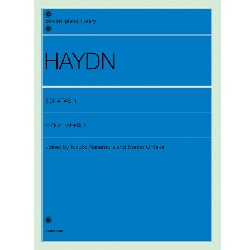Haydn, Franz Joseph : Sonate für Klavier Nr.62 Es-Dur Hob.XVI:52 op.82
Work Overview
Publication Year:1798
First Publisher:Artaria
Instrumentation:Piano Solo
Genre:sonata
Total Playing Time:18 min 30 sec
Copyright:Public Domain
Additional Notes:第62番は「ウィーン原典版」の番号
Commentary (1)
Author : Saitoh, Noriko
Last Updated: August 1, 2007
[Open]
Author : Saitoh, Noriko
This work (composed in 1794, published in 1798) is one of Haydn's latest piano sonatas. It is a rich and fulfilling piece, full of brilliance and excitement. This period, following his departure from the Esterházy family whom he had served for many years, and including his highly successful visits to London, was a time when many masterpieces were born. The sonata features a clear form with distinctly defined themes, and each movement displays a different character, ranging from dazzling splendor to calm delicacy.
Composed in 1794, after Haydn, who had often served counts and dukes, became a free musician due to the disbandment of the Esterházy orchestra. It consists of three movements.
First Movement
The first movement is in E-flat major, Allegro, 4/4 time. It begins with a close-position F major chord. A characteristic feature is the rapid and constant change in dynamics throughout the movement. From bar 27, the second theme appears in the high register, and in the development section (from bar 44), this theme is developed first. The second theme is characterized by staccato in both hands, contrasting with the slurred first theme. Furthermore, the first two bars of the development section are derived from the beginning of the movement but are marked with fermatas. This treatment of fermatas can be seen as a precursor to their use in the piano sonatas of Haydn's pupil, Beethoven.
Second Movement
The second movement is in E major, Adagio, 3/4 time. It is interesting that it is written in a key a semitone higher than the first movement. It is in ternary form, and the middle section (from bar 19) is written in the parallel minor, E minor. G major also makes an appearance in the middle of this central section. A characteristic feature is the presence of ascending scales written with ornamental techniques in various places.
Third Movement
The third movement is in E-flat major, Presto, 3/4 time, and is written in rondo form, the same key as the first movement. Whereas the previous two movements began with chords, this movement begins with five repetitions of the single third of the tonic chord. Furthermore, pauses indicated by fermatas are seen throughout. Additionally, crescendos and diminuendos are never indicated in this movement, and dynamic changes and contrasts without such gradual processes are characteristic.
Movements (3)
PTNA & Partner Channel Videos(25items) View More
Sheet Music
Scores List (11)

(株)全音楽譜出版社

ヘンレー

(株)音楽之友社

(株)音楽之友社

ヘンレー

ヘンレー

ヘンレー

ヘンレ社(ヤマハ)
















